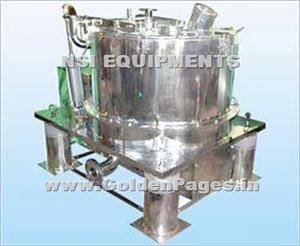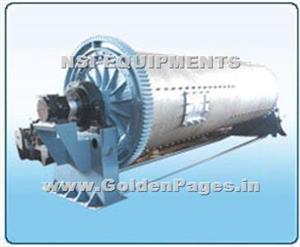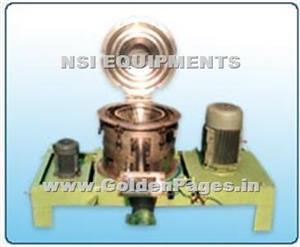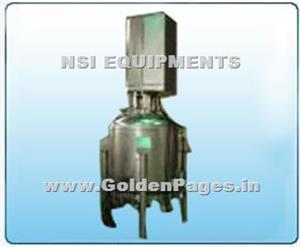NSI EQUIPMENTS P.LTD.
Featured Products
Highest quality standards are achieved through the implementations of latest technology, decades of experience and everlasting moral values , which have helped us to retain our customers as well as multiply them.
Welcome to NSI EQUIPMENTS P.LTD.
Basket Centrifuges

Principles
In basket centrifuges, the solids & liquids are separated by centrifugal force using a filter media (usually a cloth) mounted over supporting mesh, which are together supported inside the rotating basket. The slurry to be filtered is fed through the feed nozzles to the basket and due to centrifugal force the liquid is forced out through the filter media while solids are retained within the filter media inside the basket. These solids then separated or discharged by various discharging methods namely - manually, bag lifting basket, through scrapper, operated manually pneumatically / hydraulically, for which different models are available.
Suspension / Mounting :
All the bottom driven basket centrifuges can be supplied either in 3 point type suspension or the newer 4 point type mounting (on VISCO Damper / Sordino Damper) anti vibration mounts.
Material of construction :
Carbon Steel, Stainless Steel, Hastalloy, Rubber Lined,
Fluoro Polymer Coatings like Halar (ECTFE), PVDF (ETFE ), Teflon (PFA) etc.
Lining / Coating can be provided on the contact parts as well as
on the exterior body for prevention from spillage and corrosive atmosphere.
Advantages of 4 Point Mounting :
- Level of vibration is much lower & operates very smoothly.
- Can be mounted on upper floor and can be easily relocated.
- Almost negligible maintenance cost.
- Working area is free from abstracts and a clean area can be maintained.
Types / Models of Basket Centrifuges :
- Pilot Plant Centrifuge
- Bottom Driven Top Discharge Type Centrifuge
- Bag Lifting Type Centrifuge
- Bottom Discharge Type Centrifuge with/without Scrapper
- Top Driven Bottom Discharge Centrifuge
Additional Features (Optional)
- Residual Heel (Cake Removal System)
- Cleaning in Place (CIP)
- Leak Test as per DIN 24 400
- Nitrogen Blanking System
- Speed Indication with Zero Speed Switch
- Automation
- Cake Sensor
Reaction Vessels

Function
Reaction Vessels are used in carrying out a wide variety of chemical reactions including condensation, polymerization, esterification etherifciation, hydrolysis, hydration, reduction, oxidation, hydrogenation etc. at pressures (Up to 30 Kg. / cm²) and at temperatures ranging -20°C to +250°C. Reaction needing simultaneous fractional distillation and azeotropic distillation can also be conducted very efficiently using these chemical reaction vessels.
Material of Constructions
Various materials of construction, such as MS, SS304, SS 316, SS 316L, Rubber Lined etc, can be offered as per requirement.
Rotary Vacuum Dryers

|
 |
|
Ribbon Blenders

Ribbon Blender
Ribbon Blender accurately blends small proportion into large stocks and rapidly mixes and discharge.
Multiple blades set at different angles on the horizontal shaft, sweep the entire length of the mixer trough. Ribbon Blender have the effect of moving alternate sections of the mix towards the center of trough and remainder towards the outer ends. This moves and turns the whole mixture to & fro, up & down movement, leaving no pockets of unmixed material and giving a through blending in the shortest possible time.
Construction
Fabricated from heavy gauge steel, or any specified material of construction. Design aspect planned for maximum efficiency in leak proof construction. Built for long trouble free service.
- Chopper blades - 2 Nos., moving at cutting speed, are provided at diagonally opposite sides to break lumps coarse particle of the mixture.
- Liquid spraying nozzles with dozing system.
- Nitrogen (N2) blanketing
- Pneumatically operated bottom valve.
- The unit can be provided on load cells, to weight the mass accurately
- Jacket for heating / cooling
Ball Mills

The rotation of the powder mixer is usually between 4 to 20 revolutions per minute, depending upon the diameter of the mill. The larger the diameter is, the slower the rotation will be. Ball Mills are generally used to grind material ¼" and finer, down to the particle size of 20 - 75 microns.
To achieve reasonable efficiency, the ball mills are to be operated in a closed system, with oversize particles continuously being re-circulated back to the mill and to be reduced
Air Classifying Mill

ULTRA FINE AIR CLASSIFYING MILL (ACM):
Ultrafine Air Classifying Mills are used for size reduction of various products to microfine particle sizes. The system incorporates integral classifier where the fine particles of desired size are segregated and the over size particles back to the grinding chamber and re-grinded until the desired particle size is obtained. Air Classifying Mill is very compact and efficient, having sharp classifier cut points which are instantly adjustable. The system incorporates grinding and classification in one single compact space saving design.
SALIENT FEATURES :
- Grinding and Classifying in one machine
- Cool and smooth grinding
- Steep particle size distribution
- Sharp Classifier cut point, instantly adjustable.
- Easy cleaning and maintenance.
- Low specific energy requirement
- Compact space saving design.
PRINCIPLE OF OPERATION :
The material to be ground is conveyed from a hopper by screw feeder or pneumatically fed through Rotary Air Lock Feeder to the grinding chamber of the Air Classifying Mill (ACM). The pins/bars of the rotor break the particles of the material. These particles are entrained by an air stream which enters below the pin rotor and are carried up between the inner wall and the shroud ring with baffles which decrease the air swirl. These particle then enter the classifying section where the fine material is carried out with the air through the classifier rotor to the outlet, the course material is thrown against the shroud rind and carried down to the pin rotor for further reduction. After leaving the micronizer air mixed with fine particles enter the bag filter where the fine particles are separated and the clean air is discharged to the atmosphere.
Jet Mills (Fluid Energy Mills)
 21835.jpg)
Jet Mill is used for micronizing of solids of agro-chemicals, chemicals, pigments, minerals. Pharmaceuticals, thermoplastics and other heat sensitive, corrosive and abrasive materials.
PRINCIPAL OF OPERATION :
Jet Mill works on micronizing of products using compressed air instead of mechanical impacts due to which the micro size is very fine. Micro milled products are obtained in microns after the material collide with each other and reduce themselves by attrition and collision.
APPLICATION :
Jet Mill are used in industries like Agro chemicals, Chemicals, Pharmaceuticals, Ceramics, Metals, Minerals, Paints, Plastics and others like Food Colours, Fuller Earth, Toner, Wax, etc.
Rotary Kilns

|
Rotary Kilns are used to heat solids to the point where a required chemical reaction(s) takes place. The Rotary Kiln is basically a rotating inclined cylinder, solids retention time in the kiln is an important factor and is set by proper selection of diameter, length, speed, slope and the internal design.
Standard Construction Features :
Rotary Kilns are normally direct fired and lined with refractory material to protect the steel shell, reduce radiation losses and transfer heat to the material. A typical Rotary kiln is cylindrical shell, slightly inclined from the horizontal and supported on two or more tyres, which in turn rotate on rollers. One of the tyre is fixed axially by a set of thrust rollers to care of the thrust load during kiln movement. The drum assembly along with the tyres are rotated by a girth gear/ pinion arrangement. Shell diameter and length are generally designed to suit specific products. Heat Transfer in Rotary kiln : All kilns are heat exchangers and the heat is transferred in a variety of ways by radiation, convection and conduction. |
Rotary Dryers

Rotary Dryers are used to remove moisture from material using hot gases to heat the feed material and to evaporate the water. Rotary Dryers are suitable for drying wide range of materials continuously because of its ability to process material having considerable variation in size and composition.
|
 |
Agitated Nutsche Filter

Agitated Nutsche Filter is a closed vessel designed to separate solid and liquid by filtration under pressure or vacuum or in combination of both. The resulting wet cake can be re-slurried and washed thoroughly with water or solvent. The discharge of wet cake is automatic. Drying of wet cake is also possible when drying features are incorporated. The closed system ensures odourless contamination free and non-polluting working conditions maintaining product purity and hygiene. Agitated Nutsche Filters are extensively used in CHEMICAL, HERBAL, PHARMA, AGRO CHEMICAL & FOOD Industries.
DESCRIPTION
Agitated Nutsche Filter consists of a cylindrical shell with a welded dished end at the top and a flat welded end at the bottom. The vessel is divided into two compartments by means of a perforated plate, provided with suitable filter cloth. The base plate is having arrangement of bolting bar to hold the filter cloth. Suitable support mesh is provided under filter cloth to facilitate the flow of filtrate. An agitator of unique design and rigid and in “S” curved provided inside the vessel to perform the movements of vertical and rotational directions simultaneously, by means of push buttons switches/PLC. and to take the high torque generated during solid discharge and re-slurring operation.
OPERATION
Slurry is fed into the top compartment from where filtrate passes into the lower chamber en route to receiver. Solids are deposited on the filtering media in the top compartment and take the shape of cake of a uniform thickness. The agitator pushes the solid content in the slurry upwards by keeping it under suspension till maximum possible filtrate passes through the filter bed. It then seals the cracks in the cake, which develops after most of the filtrate has passed through, by smoothening the top surface of the cake.
Agitated Nutsche Filter Dryer also squeezes out some of the moisture in the cake by slightly pressing the cake uniformly with the help of specially designed blades. After the separation of solvent/mother liquor and if the cake requires washing, the entire cake can be re-slurried and agitated, so that all the particles forming the cake can be exposed to wash liquor and be thoroughly washed through the specially designed agitator. This improves quality of the finished products. After washing and removal of wash liquor, the cake can be discharged through a quick opening side discharge door, by rotating and lowering agitator in the discharge direction. No manual handling is required.
Process Steps
- Filtration
- Washing of Filter Cake
- Repeat mix or washing of the cake
- Convection drying of the cake
- Smoothing with compression of the cake
- Fully Automatic discharge of the wet or dried cake.
Advantages
- The equipment is functionally safe and easy to operate.
- No manual handling.
- Through washing of cake.
- Toxic and hazardous material can be processed.
- Product purity maintained
- Blending of product possible before discharging.
- Complete automation.
- Combining filtration, washing, re-slurry and drying in a fully enclosed automated unit thus reduction of capital and operating costs.
- Large quantities can be processed faster than the conventional systems.
- Heat transfer surface can be provided on the vessel wall by providing jacket or limpet.
Spin Flash Dryer

Spin Flash Dryer is used for effective and efficient method of removal of surface or on bound moisture from a feed product. Spin Flash Dryers are designed for continuous drying of cohesive and non-cohesive pastes, filter cakes and high viscosity liquids. Under the action of hot air and mechanical dispersion, the wet cake appears granular and gets fluidized. Instantaneous exchange of heat and mass takes place. The dried materials are taken in the collector as powder products.
The spin flash dryer system consist of double shaft screw followed by mono screw to feed homogenized material into dryer housing at controlled rate. Hot air is supplied by a temperature controlled air heater and speed controlled fan, entering the drying chamber at a tangent in order to establish a turbulent, whirling air flow. The rotor at the base of the drying chamber fluidizes the product particles and dispersed using the heat from the air stream, the material dries as it is conveyed. Drying takes place in a matter of seconds. The particle classification orifice on the top of drying chamber allows finer product to pass with exhaust gas to powder collection system while the larger particles remain in the air flow for further drying and powdering. Elevated drying temperatures can be used with many products since the flashing off of surface moisture instantly cools the drying gas without appreciably increasing the product temperature. A simple Flash Dryer is also designed to handle materials that can be suspended directly in air, requiring removal of free moisture.
Salient Features :
- High drying efficiency and low energy costs.
- Direct drying and no initial diluting.
- Continuous processing with short drying time.
Fields of Application :
- Agro chemicals
- Ceramics
- Food & Feed products
- Organic Chemicals
- Pharmaceuticals
- Pigments & dyestuffs.
Capacity Available
Up to 5 tons/hr. and the drying chamber size from 200 to 1600 mm diameter.
Material of Construction
SS & MS
Rotary Autoclave

The Rotary Autoclave is made from boiler quality plate with limpet coil for heating and with hollow agitator with blades, driven by motor and gear box.
These Rotary Autoclaves are designed to work at a pressure of 300 psi. and at a temperature of 250°C.
Agitator : Fabricated from seamless pipe & two end stubs of EN-8 are welded at both ends. The shaft is machined in assembly. Suitable keyways and seat is provided to seat the flanged hub accurately. The arms of the stirrer are welded to the hubs, which are keyed and bolted to the central shaft. The hub is flanged to the central shaft in two halves. The arms are welded with end blades. These blades are specially designed in a way that they turn and move the material longitudinally so that the same particle do not remain in contact with surface for long time & uniform heating is provided to the material inside.
Top & Bottom Mouths : Steel casted and specially designed, consist of jaw arrangement through which the mouth can be locked & unlocked by a suitable gearing arrangement at top and at bottom with a counter weight and gearing arrangement for easy open and for tight closer. Suitable neoprene runner gasket of single piece is mounted to the mouths to seal the system.
Capacity : Various models are available in capacity 2000, 3000, 3500 & 4000 kgs/batch.
Spray Dryer

The fines, which are the particles with a small diameter, will remain in the air, and it is therefore necessary to pass the air through cyclones to separate the fines. The fines leave the cyclone at the bottom via a locking device and enter the pneumatic system, too. The air passes from the cyclone to the atmosphere via the exhaust fan. The two fractions of powder are collected in the pneumatic system for conveying and cooling and are passed through a cyclone for separation, after which they are bagged off. The instrumentation comprises indication of the temperature of the inlet and outlet air, as well as automatic control of the inlet temperature by altering the steam pressure, amount of oil or gas to the air heater, and automatic control of the outlet temperature by altering the amount of feed pumped to the atomizing device.
There are two basic types of atomization :
- Nozzle atomizer
- Disc atomizer
Spray Drier Configuration :
- Co-Current Flow
- Counter Current Flow
Advantages Of Using A Spray Dryer For Drying Application :
- Control of particle size. Spray dryers can typically produce between 30 to 500 micron average particle sizes, in a bell shaped distribution.
- The shape of most spray dried particles is spherical, which provides for fluid-like flow properties.
- Spray drying produces the most homogeneous product.
- Many heat sensitive products can be spray dried easily at relatively high inlet temperatures.
- Permits drying without thermal degradation.
Multiple Effect Evaporators

Evaporators are thermal concentrators for concentrating dilute liquid for increasing the solids content and for reducing volume of evaporating liquid, widely used for the concentration of liquids in the form of solutions, suspensions and emulsions.
In Multiple Effect Evaporators (MEE), there is a conservation of heat as steam from the boiler is used for the first effect and then the vapour generated from the product is used as the heat source in the second effect. The vapour generated here is then used as the heat source in the third effect and finally heats water for some other process or preheats the incoming feed.
Multiple Effect Evaporator - Effluent Treatment :
Evaporators are used to convert entire quantity of effluent to zero liquid discharge by separating water and salt using evaporation and separation technology by concentrating the effluent to the saturation level and subsequent separation of salt and water through centrifuging and drying.
Industries like Textile Dying, Pharmaceutical & Drug Industries, Pulp mills etc. during the manufacturing process generates huge quantity of high toxic effluents which has high BOD, COD, TS and TDS level with black coloured and odour effluent. To overcome all the environmental problems, Zero Liquid Discharge Effluent System is required depending upon the type of effluent for evaporation and drying.
Our Vision
* To embrace new technologies and methods. * To give unsurpassed products and services to the clients. * To constantly look for improvement and changes.









 21835.jpg)




